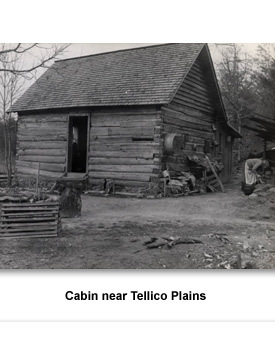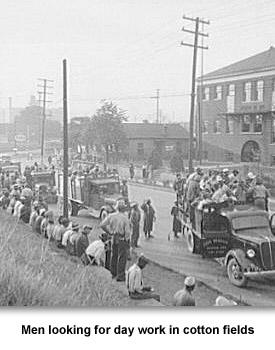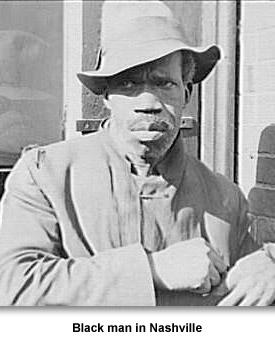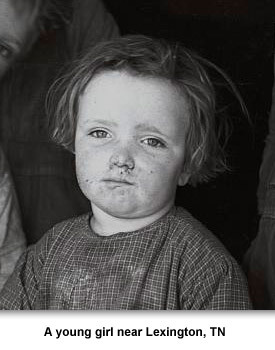The Great Depression & WW II
The Great Depression
For many Tennesseans the Great Depression from 1929 to 1941 was a time of great hardship. This national crisis affected people who lived in cities, small towns, and rural communities.
Many people lost their jobs. Tennessee farmers had a hard time making a living in the 1920s, and it got worse in the 1930s. Families suffered from the strain of trying to survive.
Most Tennesseans did not allow the Depression to defeat them. Instead, hard times inspired some important changes. For the first time, many Tennesseans approved of the federal government taking a greater role in daily life.
Through New Deal programs, people found jobs. They worked on public projects like building schools and roads, developing parks, and conserving the land.
The Tennessee Valley Authority built dams that controlled floods and produced electricity for many homes and businesses. Many Tennesseans who lived in rural areas began to have access to electric power. Public projects from the 1930s continue to benefit Tennesseans today.
One song that seemed to represent what was happening to the average man was "Brother, Can You Spare a Dime?" It was wildly popular with the public, and became the unofficial anthem for the Great Depression .The co-author, E.Y. Harburg, who wrote the lyrics, said he wrote it for the "everyday" man who had built his faith and hope in his country. Then came the stock market crash. "He just can't understand what could have happened to make everything go wrong," Harburg said.
http://tn4me.org/audio/BrotherCanYouSpareDime.mp3
For more on the Depression, visit:
Picture Credits:
- A mother in a family of nine holds one of her children as another child stands beside her. She is wearing a feed sack as a skirt. The family was photographed by Carl Mydans, a New Deal photographer, in 1936. He saw them living in a field next to U.S. 70 in Tennessee, near the Tennessee River. Library of Congress
- A young girl photographed as she lived with her family on the Natchez Trace Project near Lexington, Tennessee. Photographer was Carl Mydans, employed with a New Deal project. Library of Congress
- Black man standing on a street in Nashville. The photograph was identified as being shot during a street religious meeting in September 1935. Photographer was Ben Shahn who worked on a New Deal photography project. Library of Congress
- African Americans in Memphis looking for day work in Arkansas cotton fields in 1937. Truck drivers were paid by owners in Arkansas to recruit workers each day. Trucks left at 5 a.m. and returned after sundown. Photographer was Dorothea Lange, employed through a New Deal project. Library of Congress
- A 1939 photograph taken of a cabin near Tellico Plains, Monroe County. A woman is working in the yard on the right. Notice the tools and tub hanging on the wall. Tennessee Department of Conservation Collection, Tennessee Library and Archives
Acknowledgments:
Music is "Brother, Can You Spare a Dime?" by Leo Reisman and His Orchestra with the vocals by Milton Douglas. Recorded October 1932. ASCAP. This song was originally written for a revue by E.Y. Harburg and Jay Gorney.
The Great Depression & WW II >> The Great Depression >>





 Sponsored by: National Endowment for the Humanities
Sponsored by: National Endowment for the Humanities